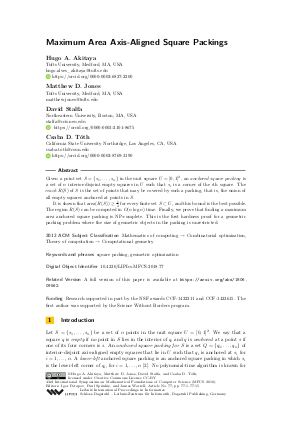Maximum Area Axis-Aligned Square Packings
Authors
Hugo A. Akitaya  ,
Matthew D. Jones,
David Stalfa
,
Matthew D. Jones,
David Stalfa  ,
Csaba D. Tóth
,
Csaba D. Tóth 
-
Part of:
Volume:
43rd International Symposium on Mathematical Foundations of Computer Science (MFCS 2018)
Part of: Series: Leibniz International Proceedings in Informatics (LIPIcs)
Part of: Conference: Mathematical Foundations of Computer Science (MFCS) - License:
 Creative Commons Attribution 3.0 Unported license
Creative Commons Attribution 3.0 Unported license
- Publication Date: 2018-08-27
File

PDF
LIPIcs.MFCS.2018.77.pdf
- Filesize: 0.83 MB
- 15 pages
Document Identifiers
Related Versions
Subject Classification
ACM Subject Classification
- Mathematics of computing → Combinatorial optimization
- Theory of computation → Computational geometry
Keywords
- square packing
- geometric optimization
Metrics
- Access Statistics
-
Total Accesses (updated on a weekly basis)
0PDF Downloads0Metadata Views
Abstract
Given a point set S={s_1,... , s_n} in the unit square U=[0,1]^2, an anchored square packing is a set of n interior-disjoint empty squares in U such that s_i is a corner of the ith square. The reach R(S) of S is the set of points that may be covered by such a packing, that is, the union of all empty squares anchored at points in S.
It is shown that area(R(S))>= 1/2 for every finite set S subset U, and this bound is the best possible. The region R(S) can be computed in O(n log n) time. Finally, we prove that finding a maximum area anchored square packing is NP-complete. This is the first hardness proof for a geometric packing problem where the size of geometric objects in the packing is unrestricted.
Cite As Get BibTex
Hugo A. Akitaya, Matthew D. Jones, David Stalfa, and Csaba D. Tóth. Maximum Area Axis-Aligned Square Packings. In 43rd International Symposium on Mathematical Foundations of Computer Science (MFCS 2018). Leibniz International Proceedings in Informatics (LIPIcs), Volume 117, pp. 77:1-77:15, Schloss Dagstuhl – Leibniz-Zentrum für Informatik (2018)
https://doi.org/10.4230/LIPIcs.MFCS.2018.77
BibTex
@InProceedings{akitaya_et_al:LIPIcs.MFCS.2018.77,
author = {Akitaya, Hugo A. and Jones, Matthew D. and Stalfa, David and T\'{o}th, Csaba D.},
title = {{Maximum Area Axis-Aligned Square Packings}},
booktitle = {43rd International Symposium on Mathematical Foundations of Computer Science (MFCS 2018)},
pages = {77:1--77:15},
series = {Leibniz International Proceedings in Informatics (LIPIcs)},
ISBN = {978-3-95977-086-6},
ISSN = {1868-8969},
year = {2018},
volume = {117},
editor = {Potapov, Igor and Spirakis, Paul and Worrell, James},
publisher = {Schloss Dagstuhl -- Leibniz-Zentrum f{\"u}r Informatik},
address = {Dagstuhl, Germany},
URL = {https://drops.dagstuhl.de/entities/document/10.4230/LIPIcs.MFCS.2018.77},
URN = {urn:nbn:de:0030-drops-96594},
doi = {10.4230/LIPIcs.MFCS.2018.77},
annote = {Keywords: square packing, geometric optimization}
}
Author Details
Funding
Research supported in part by the NSF awards CCF-1422311 and CCF-1423615. The first author was supported by the Science Without Borders program.
References
- Kevin Balas, Adrian Dumitrescu, and Csaba D. Tóth. Anchored rectangle and square packings. Discrete Optimization, 26:131-162, 2017. URL: http://dx.doi.org/10.1016/j.disopt.2017.08.003.
- Kevin Balas and Csaba D. Tóth. On the number of anchored rectangle packings for a planar point set. Theor. Comput. Sci., 654:143-154, 2016. URL: http://dx.doi.org/10.1016/j.tcs.2016.03.007.
-
Jon L. Bentley. Solutions to Klee’s rectangle problems. unpublished manuscript, 1977.

- Timothy M. Chan. Klee’s measure problem made easy. In Proc. 54th Annual IEEE Symposium on Foundations of Computer Science, pages 410-419, 2013. URL: http://dx.doi.org/10.1109/FOCS.2013.51.
- Mark de Berg and Amirali Khosravi. Optimal binary space partitions for segments in the plane. Int. J. Comput. Geometry Appl., 22(3):187-206, 2012. URL: http://www.worldscinet.com/doi/abs/10.1142/S0218195912500045.
- Adrian Dumitrescu and Csaba D. Tóth. Packing anchored rectangles. Combinatorica, 35(1):39-61, 2015. URL: http://dx.doi.org/10.1007/s00493-015-3006-1.
- Michael Formann and Frank Wagner. A packing problem with applications to lettering of maps. In Robert L. Scot Drysdale, editor, Proc. 7th Annual Symposium on Computational Geometry, pages 281-288. ACM, 1991. URL: http://dx.doi.org/10.1145/109648.109680.
- Claudia Iturriaga and Anna Lubiw. Elastic labels around the perimeter of a map. J. Algorithms, 47(1):14-39, 2003. URL: http://dx.doi.org/10.1016/S0196-6774(03)00004-X.
- Joo-Won Jung and Kyung-Yong Chwa. Labeling points with given rectangles. Inf. Process. Lett., 89(3):115-121, 2004. URL: http://dx.doi.org/10.1016/j.ipl.2003.09.017.
- Konstantinos G. Kakoulis and Ioannis G. Tollis. Labeling algorithms. In Roberto Tamassia, editor, Handbook on Graph Drawing and Visualization., pages 489-515. Chapman and Hall/CRC, 2013. URL: https://www.crcpress.com/Handbook-of-Graph-Drawing-and-Visualization/Tamassia/9781584884125.
- Klara Kedem, Ron Livne, János Pach, and Micha Sharir. On the union of Jordan regions and collision-free translational motion amidst polygonal obstacles. Discrete & Computational Geometry, 1:59-70, 1986. URL: http://dx.doi.org/10.1007/BF02187683.
- Donald E. Knuth and Arvind Raghunathan. The problem of compatible representatives. SIAM J. Discrete Math., 5(3):422-427, 1992. URL: http://dx.doi.org/10.1137/0405033.
- Atsushi Koike, Shin-Ichi Nakano, Takao Nishizeki, Takeshi Tokuyama, and Shuhei Watanabe. Labeling points with rectangles of various shapes. Int. J. Comput. Geometry Appl., 12(6):511-528, 2002. URL: http://dx.doi.org/10.1142/S0218195902001018.
-
Giri Narasimhan and Michiel H. M. Smid. Geometric Spanner Networks. Cambridge University Press, 2007.

-
William T. Tutte, editor. Recent Progress in Combinatorics, New York, 1969. Academic Press. Proceedings of the 3rd Waterloo Conference on Combinatorics, May, 1968.

- Marc J. van Kreveld, Tycho Strijk, and Alexander Wolff. Point labeling with sliding labels. Comput. Geom., 13(1):21-47, 1999. URL: http://dx.doi.org/10.1016/S0925-7721(99)00005-X.
- Hakan Yildiz and Subhash Suri. Computing Klee’s measure of grounded boxes. Algorithmica, 71(2):307-329, 2015. URL: http://dx.doi.org/10.1007/s00453-013-9797-9.
